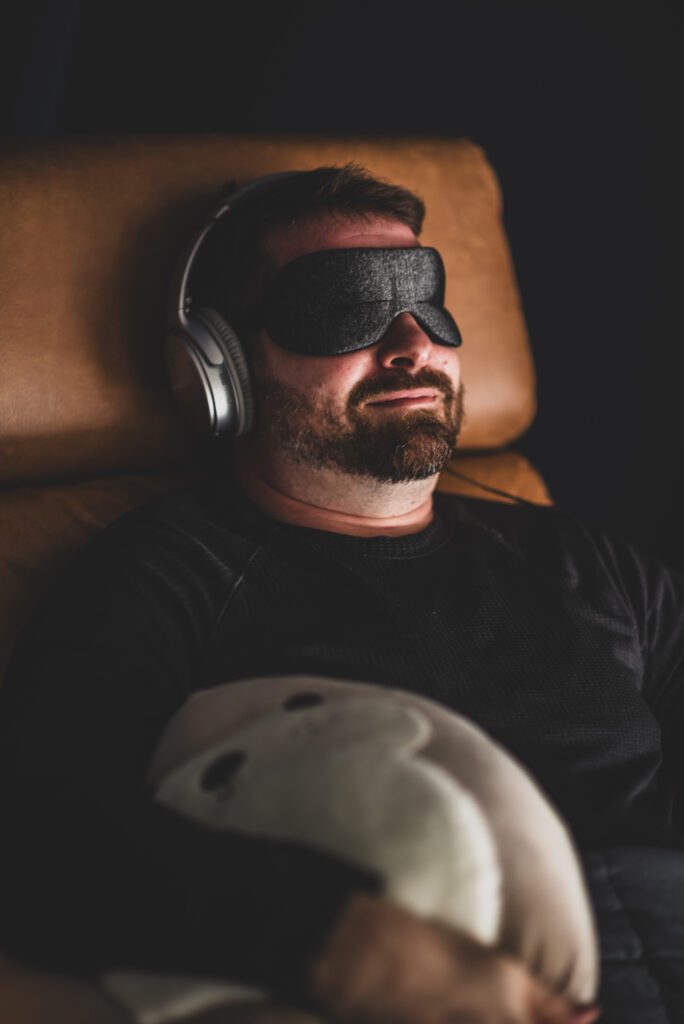
You may be reading this because anxiety is no longer just an occasional visitor in your life. It’s the guest who moved in, changed the locks, and rearranged the furniture. You are not alone. In fact, roughly one-third of adults in the US will meet diagnostic criteria for an anxiety disorder at some point. That is an enormous number – tens of millions of people who wake up each morning already bracing for fight-or-flight.
Here’s the part that frustrates me as a physician: standard treatments leave far too many of those individuals without meaningful relief. Up to 30% of patients become “treatment-resistant,” meaning they have cycled through at least two adequate courses of medication and therapy with little to show but side-effects and dashed hope. I’ve seen that disappointment turn into self-blame. You start to wonder, “Is there something uniquely broken about me?” The answer is an emphatic no.
I founded Field Trip Health because I was determined to build a clinic where you could reclaim agency over your mind – even if you’ve spent years feeling stuck. Today, I want to walk you through why anxiety sometimes resists conventional care, how Ketamine-Assisted Psychotherapy (KAP) can reopen neural pathways, and what you can expect if you decide to work with my team.
Understanding Treatment-Resistant Anxiety (TRA)
When we label anxiety “treatment-resistant,” we’re not being dramatic. We’re describing a specific clinical scenario. You would typically have tried at least two evidence-based first-line interventions – most commonly a selective serotonin reuptake inhibitor (SSRI) and a structured psychotherapy such as cognitive-behavioral therapy (CBT) – at proper dose and duration. Despite that, the core symptoms remain:
- hyper-vigilance
- intrusive worry
- muscle tension
- sleep disruption
- or panic attacks
Why Anxiety Becomes Resistant
Neuroscience tells us that chronic stress can hard-wire anxiety circuits. Over time, dendritic spines in the prefrontal cortex shrink, while the amygdala, the brain’s alarm center, remains on perpetual high alert.
Trauma compounds this rigidity. Unprocessed memories keep pushing the “danger” button even when you are perfectly safe.
Physiological factors – hormonal imbalances, inflammatory states, and untreated pain – can further anchor the pattern. Add real-world stressors such as debt or caregiving, and you have a potent brew that simple serotonin modulation may not resolve.
I have watched patients do everything “right”: they swallowed pills at the same hour every day, showed up faithfully to therapy, practiced breathing exercises, and still found themselves white-knuckling through social events or work presentations. When that happens, the problem isn’t your effort. It’s that your brain circuitry needs a different kind of jump-start.
Conventional Care: Strengths, Gaps, and the Moment You Realize It’s Not Enough
First, let me be clear: I prescribe SSRIs, SNRIs, and benzodiazepines when indicated. For many, these medications provide life-changing relief. The evidence base is robust, and you will never hear me dismiss a therapy that works. However, I also know that pharmaceutical timelines often clash with real-world urgency. SSRIs can take six to eight weeks to reach peak efficacy. Someone teetering on the edge of burnout or contemplating self-harm may not have that luxury.
Then there is the side-effect profile. Sexual dysfunction, emotional blunting, nausea, and weight gain can knock the wind out of your motivation. You can’t blame people for discontinuing a pill that makes daily life feel hazy or physically uncomfortable. Meanwhile, talk therapy depends on vulnerability, and severe anxiety often blocks exactly that emotional openness. I once worked with a corporate executive who could outline cognitive distortions perfectly in theory, yet her shoulders would lock the moment we tried to connect the dots to her father’s temper.
When strong effort still yields weak results, it is time to explore an approach capable of prying open those neural knots in a fundamentally different way.
Ketamine-Assisted Psychotherapy (KAP)
There are times when traditional methods simply can’t crack through the reinforced defenses built by years of persistent anxiety or trauma. Ketamine-assisted psychotherapy provides a radically different entry point.
How Ketamine Works at the Synaptic Level
Ketamine, originally an anesthetic, acts primarily as an NMDA receptor antagonist, which triggers a cascade of glutamate release. That biochemical domino effect ramps up neuroplasticity by boosting brain-derived neurotrophic factor (BDNF). Think of BDNF as miracle-grow for neurons. It encourages the growth of new dendrites, allowing signals to travel through routes that were previously overgrown or eroded.
When anxiety has carved deep trenches in your thought patterns, this burst of plasticity can feel like the mental equivalent of fresh snowfall – tracks can finally shift.
The Synergy of Ketamine and Psychotherapy
If ketamine is the snowfall, psychotherapy is the sled that shapes where new tracks form. The medicine loosens the grip of rigid fear circuits, giving you a temporary vantage point from which to examine memories and beliefs with unprecedented clarity. Guided conversation during or soon after that window cements insight into actionable change.
In my sessions, I’ve seen clients connect dots between childhood night terrors and adult workplace avoidance, moments that years of standard talk therapy never managed to surface.
A randomized study published in JAMA Psychiatry found statistically significant symptom reduction within 24 hours of the first ketamine infusion. When I first observed such speed in my own clinic, I honestly had to triple-check the data. I’d argue that no other legally available compound offers this combination of rapidity and safety for anxiety.
How Field Trip Health Transforms Data Into Day-to-Day Care
I established Field Trip Health on three pillars: physician-led safety, spa-level comfort, and technology that extends care beyond clinic walls. Our KAP clinics in Toronto, Vancouver, Montreal, Ottawa, Hamilton, Kitchener-Waterloo, Thunder Bay, Sault Ste. Marie, and Regina all share the same blueprint: warm lighting, nature-inspired artwork, and private dosing suites equipped with emergency medical gear most clients never see because we keep it discreetly behind cabinet doors.
Safety protocols start long before the first milligram of ketamine touches your bloodstream. You complete a detailed medical questionnaire and, if necessary, lab work. We screen out contraindications such as uncontrolled hypertension, active psychosis, or pregnancy. During in-clinic infusions, a registered nurse monitors your vitals while a psychotherapist remains on standby to enter the room at prearranged checkpoints or whenever you request support.
Accessibility is equally important. I know that geography, caregiving duties, or pandemic-era travel anxieties can make in-person care impractical. That is why we offer a physician-supervised at-home program. Clients routinely tell me the hybrid model lets them integrate insights immediately into their living environment – no dramatic re-entry from clinic serenity into household chaos.
Supporting all of this is the Field Trip app (available on Apple and Android). Guided meditations, playlists designed to extend the therapeutic arc, and journaling prompts are available at any hour. The app may sound like a minor perk, yet the data say otherwise. Clients who use the app regularly sustain symptom gains longer than infrequent users – a finding our research team is preparing for publication.
Walking You Through a Typical Field Trip Program

Let me show you, step by step, what it actually feels like to participate in a Field Trip program – from that very first intake conversation to the personalized support you receive throughout. I want to demystify the journey, so you know exactly what to expect at every stage.
Preparing: Laying the Foundation for Neuroplastic Change
Your journey begins with a 90-minute intake conversation. We discuss medical history, medication interactions, and the emotional goals you hope to achieve. I often ask, “If anxiety loosened its grip tomorrow, what specific change would you notice first?” That clarity anchors the work ahead. You then complete mindfulness exercises designed to help you observe bodily sensations without judgment. When ketamine later amplifies those sensations, you’re already fluent in the language.
Dosing Day: Entering the Window of Possibility
When you arrive for your first ketamine infusion, you choose aromatherapy – lavender to soften the edges or perhaps eucalyptus for grounding. You settle into a zero-gravity recliner, don noise-canceling headphones, and allow the curated soundtrack to guide your emotional tempo. Within minutes of the ketamine infusion starting, the usual chatter recedes. Some clients describe floating over a topographic map of their life. Others feel a gentle expansion, as if their torso has room to inhale for the first time in years. You remain conscious and capable of communication. The nurse will ask about nausea or discomfort, adjusting the drip rate if needed.
Integration: Converting Insight Into Action
Within 24 to 72 hours you sit down – virtually or in person – with your psychotherapist. It is in this setting that ketamine’s transformative potential fuses with the hard work of self-improvement.
Together you translate vivid session imagery or newfound emotional space into concrete steps. Perhaps you realize your Sunday night dread is not just “work stress” but the echo of parental disapproval, and you commit to a boundary-setting conversation with your boss. The therapist helps you rehearse that dialogue, identifies likely anxiety spikes, and arms you with grounding exercises.
Maintenance: Sustaining the Momentum
Most treatment-resistant anxiety protocols involve four to six sessions over a month, followed by booster doses two or three times annually. You’ll also have access to alumni circles that function like miniature support ecosystems. Clients swap playlists, troubleshoot meditation roadblocks, and celebrate milestones – “First anxiety-free flight in 15 years!” – that would make any clinician’s heart swell.
Real-World Impact: A Voice That Mirrors Your Hopes

After years of depression fused with social anxiety, Janine completed a three-week Field Trip program and later wrote: “It was like I was born with a new brain after going through those sessions.”
I include her words not to promise instant bliss but to underline what can happen when neurobiology, psychotherapy, and personal readiness converge.
Janine did the prep work – journaling and spiritual exploration – that primed her mind for change. She also returned for maintenance sessions, proving that quick relief can evolve into durable transformation when nurtured.
Safety First: What You Need to Know Before You Decide
You may wonder whether medical ketamine is addictive. While recreational misuse at rave-level doses carries risk, controlled therapeutic protocols do not. We limit take-home quantities, schedule mandatory check-ins, and integrate substance-use psychoeducation when necessary.
Side-effects are usually mild and short-lived. A transient rise in blood pressure is the most common physiological change. Nausea and dizziness follow in a minority of clients, and we keep anti-emetics ready. I can tell you that during my ten-plus years in hospital medicine, I have witnessed far more serious adverse events from routine antibiotic allergies than from hundreds of ketamine infusions.
Practical Guidance if You Are Considering Ketamine Therapy
Start by clarifying your “why.” Write down the specific ways anxiety shrinks your life – from skipping your child’s recital to dodging promotions. This exercise sharpens motivation when sessions stir vulnerable memories.
Next, assess readiness honestly. Can you block out recovery time after each dose? Have you lined up a friend to drive you home or text-check later that evening? Self-care logistics determine not just comfort but outcome.
Vet providers carefully. Look for physician leadership, on-site emergency equipment, and clear exclusion criteria. Ask whether psychotherapy is bundled or merely suggested; separation between dosing and integration undermines efficacy.
Budget not only dollars but also emotional bandwidth – your first month may involve frequent appointments and introspection.
Finally, plan to sustain gains. That means scheduling booster sessions before backsliding becomes a crisis and embracing daily practices such as breathwork, journaling, or guided app meditations.
What will I actually see or feel during a ketamine session?
Experiences vary widely. Some people watch vibrant geometric patterns. Others feel a comforting sense of being held by warm light. A significant portion report no visual phenomenon whatsoever but rather a cognitive shift – thoughts grow quieter, and inner narratives lose their sting.
Will I lose control?
You remain conscious and able to speak. We monitor you throughout, and you can request the infusion be slowed or paused. Most clients describe the state as relaxing rather than disorienting.
Can ketamine cure anxiety forever?
In my professional opinion – and I say this as someone who wants nothing more than to hand each patient a permanent solution – ketamine is a catalyst, not a cure-all. It opens a door. You still must walk through, practice new skills, and keep your nervous system healthy with sleep, nutrition, and movement.
Lifestyle Levers That Reinforce Neurochemical Gains
In my experience, ketamine acts like a reset button, but what happens afterward depends heavily on lifestyle choices.
Prioritize sleep. Seven to nine hours give your brain time to consolidate new dendrites.
Support that biology with nutrition rich in omega-3 fatty acids – salmon, flaxseed, walnuts – because cell membranes need quality building blocks.
Move your body daily. You don’t need marathon ambitions.
A brisk 20-minute walk elevates endorphins and increases cerebral blood flow.
Community matters, too. Social isolation is gasoline on the anxiety fire. Whether through our alumni groups or a local book club, stay connected.
Why Field Trip Health May Be the Right Fit for You
When I built our model, I insisted on three non-negotiables.
First, rapid relief should be possible even for cases labeled “treatment-resistant.”
Second, care must be accessible in-clinic and at home, because mental health doesn’t respect geography.
Third, you need tools for self-exploration long after the IV line is removed.
Our outcomes so far tell me we hit that trifecta.
Conclusion
You may have stumbled on this article at 3 a.m., palms sweaty, heart racing, cursor hovering over a crisis-hotline number. Or perhaps you’re simply tired of white-knuckling through board meetings and family dinners. Whatever brought you here, know that options extend beyond yet another SSRI trial or stoic endurance.
Remember Janine’s simple yet profound reflection: “It was like I was born with a new brain after going through those sessions.” That level of change is not a fantasy. It’s a documented possibility when scientific rigor meets compassionate care. I think that if you commit to the full journey – preparation, dosing, integration, and lifestyle synergy – you can unlock a version of yourself you may barely remember: one who greets morning light without dread.
My team and I stand ready to walk the path with you – step by step, breath by breath – toward a calmer, more vibrant future. If anxiety has been rewriting your story, perhaps it’s time to pick up the pen together.
Yours in health and hope,
Dr. Mario Nucci
Frequently Asked Questions
Common side effects are typically mild and brief, including a temporary blood pressure increase, nausea, or central nervous system effects like dizziness in some clients. Anti-emetics are available for symptom management. Field Trip Health has documented zero cases of substance abuse or dependency, and serious adverse events or increased anxiety symptoms are extremely rare.
A typical Field Trip Health program for treatment-resistant anxiety involves four to six sessions over a month, followed by booster doses two or three times annually. The program includes preparation, dosing days, integration sessions, and ongoing support through the Field Trip app and alumni circles to help sustain momentum and maintain long-term benefits.
Field Trip Health clinics are physician-led, ensuring high standards of medical care. The team includes registered nurses who monitor vital signs during infusions and psychotherapists who provide support during and after sessions. The clinics are equipped with emergency medical gear, and all staff members are trained in safety protocols to ensure client well-being.
The Field Trip app provides guided meditations, playlists designed to extend the therapeutic arc, and journaling prompts accessible at any time. Research shows that clients who use the app at least four times per week sustain symptom gains longer than infrequent users. The app serves as a vital tool for ongoing support and integration of the treatment experience.
To reinforce neurochemical gains, Field Trip Health recommends prioritizing sleep (7-9 hours nightly), consuming a diet rich in omega-3 fatty acids, engaging in daily physical activity (even brief walks), and maintaining social connections. The Field Trip app provides tools like breathwork tracks and discussion boards to support ongoing self-care and community engagement.
About the Author

Dr. Mario Nucci MD CCFP is a licensed Family Physician with a passion for mental health and the development of new therapies. He is actively engaged in research with a faculty associate professorship at Northern Ontario School of Medicine, and research collaborations with the University of Ottawa, University of Calgary, Lakehead University, Concordia University and Vancouver Island University.
Dr. Nucci is the founder of Bay and Algoma Health Centre in 2019, a walk-in and addiction medicine clinic. He founded the Canadian Centre for Psychedelic Healing in 2019, now operating as Field Trip Health, providing cutting edge mental health care in Toronto, Montreal, Vancouver, Ottawa, Hamilton, Kitchener-Waterloo, Thunder Bay, Sault Ste. Marie, and at-home (BC, ON, & QC).